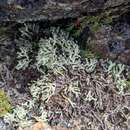Allocetraria is a genus of lichenized fungi in the family Parmeliaceae. It consists of 12 species, with a center of distribution in China.
Systematics
The genus was circumscribed by Syo Kurokawa and Ming-Jou Lai in 1991, with three species: both A. ambigua and the type species A. stracheyi recombined from different genera, and a newly described species, A. isidiigera.[1] Sunsequent molecular phylogenetic analyses showed that Allocetraria forms a monophyletic group within the cetrarioid clade in the family Parmeliaceae.[2][3][4]
In 2017, Divakar and colleagues used a then-recently developed "temporal phylogenetic" approach to identify temporal bands for specific taxonomic ranks in the family Parmeliaceae, suggesting that groups of species that diverged within the time window of 29.45–32.55 million years ago represent genera. They proposed to synonymize Allocetraria (and several other genera) with Cetraria, because the former group of species originated relatively recently and fell under the timeframe threshold for genus level. The net result of this proposal was to reduce 13 previously accepted genera in the cetrarioid clade down to two.[5] This synonymy was not accepted in a later critical analysis of this technique for lichen systematics.[6] Arve Elvebakk and colleagues expressed a similar opinion, stating that they would "prefer a model of 13 imperfectly defined cetrarioid core genera in addition to ‘orphaned’ species, over an alternative of only two widely defined ones, as a starting point for further phylogenetic studies".[7]
Description
Distinguishing features of the genus include a palisade plectenchymatous upper cortex, asci with a broad axial body, ascospores that are more or less spherical, and threadlike (filiform) pycnoconidia.[8] Species in the genus produce the secondary chemical usnic acid, but never atranorin.[1] Lichesterinic and protolichesterinic acids are found in most species.[9]
Habitat and distribution
The main area of distribution of Allocetraria is China, as nearly all the species occur there.[9][10]
Species
Former Allocetraria species:
References
-
^ a b c d e Kurokawa, S.; Lai, M.Y. (1991). "Allocetraria, a new lichen genus in the Parmeliaceae". Bulletin of the National Science Museum Tokyo. 17: 59–65.
-
^ Saag, A.; Randlane, T.; Thell, A.; Obermayer, W. (2002). "Phylogenetic analysis of cetrarioid lichens with globose ascospores". Proceedings of the Estonian Academy of Sciences, Biology, Ecology. Vol. 51. pp. 103–123.
-
^ Thell, Arne; Högnabba, Filip; Elix, John A.; Feuerer, Tassilo; Kärnefelt, Ingvar; Myllys, Leena; Randlane, Tiina; Saag, Andres; Stenroos, Soili; Ahti, Teuvo; Seaward, Mark R.D. (2009). "Phylogeny of the cetrarioid core (Parmeliaceae) based on five genetic markers". The Lichenologist. 41 (5): 489–511. doi:10.1017/s0024282909990090. hdl:1885/51099.
-
^ Nelsen, Matthew P.; Chavez, Natali; Sackett-Hermann, Erin; Thell, Arne; Randlane, Tiina; Divakar, Pradeep K.; Rico, Víctor J.; Lumbsch, H. Thorsten (2011). "The cetrarioid core group revisited (Lecanorales: Parmeliaceae)". The Lichenologist. 43 (6): 537–551. doi:10.1017/s0024282911000508.
-
^ Divakar, Pradeep K.; Crespo, Ana; Kraichak, Ekaphan; Leavitt, Steven D.; Singh, Garima; Schmitt, Imke; Lumbsch, H. Thorsten (2017). "Using a temporal phylogenetic method to harmonize family- and genus-level classification in the largest clade of lichen-forming fungi". Fungal Diversity. 84: 101–117. doi:10.1007/s13225-017-0379-z. S2CID 40674310.
-
^ Lücking, Robert (2019). "Stop the abuse of time! Strict temporal banding is not the future of rank-based classifications in Fungi (including lichens) and other organisms". Critical Reviews in Plant Sciences. 38 (3): 199–253. doi:10.1080/07352689.2019.1650517. S2CID 202859785.
-
^ Elvebakk, Arve; Bjerke, Jarle W.; Nilsen, Lennart (2018). "The lichen Allocetraria madreporiformis in high-arctic steppes on Svalbard: a result of out-of-Tibet migration?" (PDF). Graphis Scripta. 30 (1): 1–11.

-
^ a b c d e f g Thell, Arne; Randlane, Tiina; Kärnefelt, Ingvar; Gao, Xianqun; Saag, Andres (1995). "The lichen genus Allocetraria (Ascomycotina, Parmeliaceae)". In Daniels, Fred J.A. (ed.). Flechten Follmann. Contributions to lichenology in honour of Gerhard Follmann. The geobotanical and phytotaxonomical study group, Botanical Institute, University of Cologne, Germany. pp. 353–379. ISBN 978-3-87429-380-8.
-
^ a b c Wang, R.F.; Wei, X.L.; Wei, J.C. (2015). "The genus Allocetraria (Parmeliaceae) in China". Mycotaxon. 130 (2): 577–591. doi:10.5248/130.577.
-
^ a b Wang, Rui-Fang; Wei, Xin-Li; Wei, Jiang-Chun (2015). "A new species of Allocetraria (Parmeliaceae, Ascomycota) in China". The Lichenologist. 47: 31–34. doi:10.1017/S0024282914000528.
-
^ Wang, R.F.; Wang, L.S.; Wei, J.C. (2014). "Allocetraria capitata sp. nov. (Parmeliaceae, Ascomycota) from China". Mycosystema. 33 (1): 19–22.
-
^ a b Kärnefelt, I.; Thell, A. (1996). "A new classification for the Dactylina/Dufourea complex". Nova Hedwigia. 62: 487–511.
-
^ a b c Randlane, T.; Saag, A. (1992). "New combinations of some cetrarioid lichens (Parmeliaceae)". Mycotaxon. 44 (2): 491–493.


